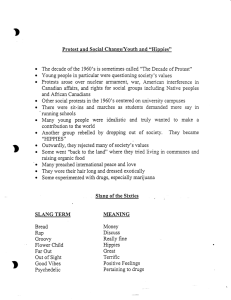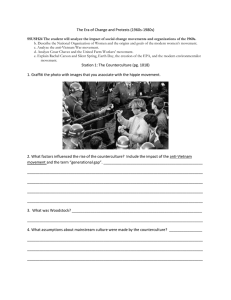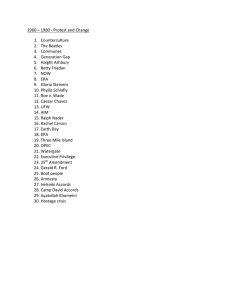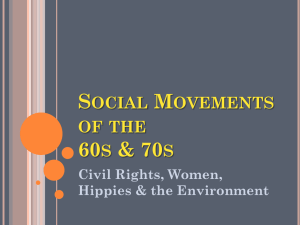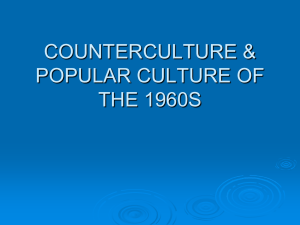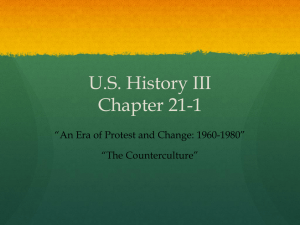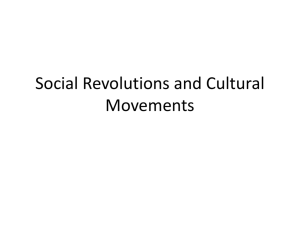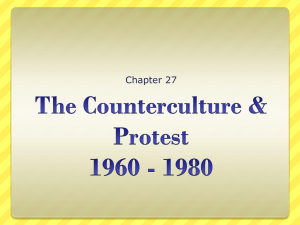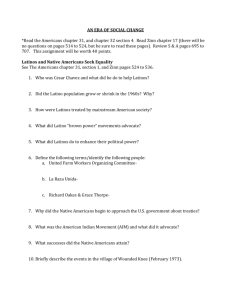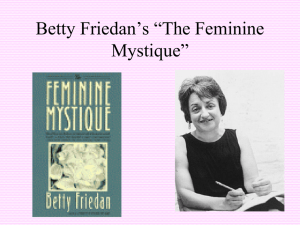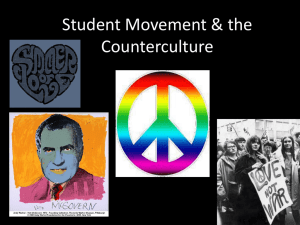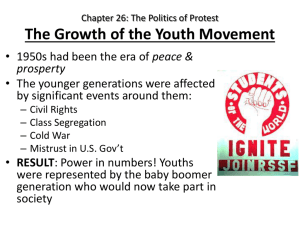The Politics of Protest
advertisement
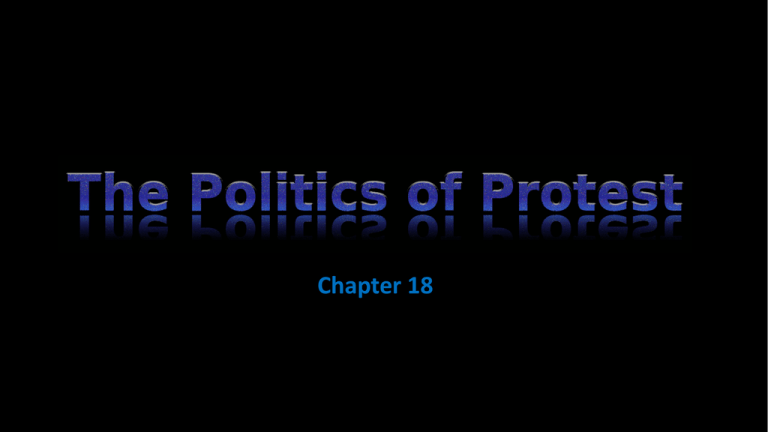
Chapter 18 • Students will be able to explain the different features of the student movement and the counterculture • Students will be able to discuss the feminist movement • Students will be able to explain new civil rights challenges and solutions to some of those challenges • Students will be able to explain Americans’ new focus on environmentalism • 1960s – one of most turbulent periods in US history Large youth movement Prosperity of 1950s Boom in college enrollment Youth questioning values of parents • Students for a Democratic Society (SDS) Called for protest against big corporations and government Occupied college buildings in protest Students with the SDS protest • The Free Speech Movement University of California at Berkley restricted students’ right to distribute literature and recruit volunteers for political causes Students protested – police broke up demonstrations Caused more demonstrations Supreme Court ruled that students had a right to free speech and assembly Police arrest protestors at USC Berkley • The Counterculture Rebellion against dominant culture Hippies Utopian society Drug use Rise of communes – group living arrangements in which everything was shared Hippies • New Religious Movements • Unification Church Founded by Korean Sun Myung Moon Claimed he was the next Messiah • Hare Krishna Movement Based on Hindi sect worshipping the god Krishna Worshippers emulated early Hindus in dress, diet and style of living Members of the Hare Krishna Sect in California • Decline of Counterculture Glamor of drug use waned Hippies “grew up” Rise of crime in hippy areas • Impact of Counterculture Fashion – colorful costumes / long hair Art – pop art from comic books / popular culture Music & Dance – Beatles, Bob Dylan, Jimi Hendrix, Woodstock • Feminist Movement Women increasingly dissatisfied w/ roles of homemaker and unequal status in workplace Feminism – belief that men and women should be equal politically, economically, and socially Equal Rights Amendment – Congress ignored due to division among women By 1960, 40% of women in workforce but paid less Feminist demonstration • Fighting for Workplace Rights President’s Commission on the Status of Women – established by President Kennedy & Eleanor Roosevelt 1963 Equal Pay Act – outlawed paying men more than women for same job Title VII – outlawed job discrimination based on race, color, religion, national origin, and gender Equal Employment Opportunity Commission – investigated cases of discrimination • The Feminine Mystique (Betty Friedan) – discussed women’s lack of fulfillment • National Organization for Women (NOW) Founded by Friedan Fought for educational and economic opportunities for women Organization magazine edited by Gloria Steinem Betty Friedan • Title IX – prohibited federally funded schools from discriminating against females • Roe v. Wade Abortion regulated by state law Supreme Court ruled states could not regulate abortion in first three months of pregnancy – violated “right to privacy” Caused rise of ”Right to Life” movement • Equal Rights Amendment (ERA) Passed by Congress in 1972 Needed ratification by 38 states to become law Ratified by 35 states Opposition to amendment led by Phyllis Schlafly ERA finally failed in 1982 Conservative activist Phyllis Schlafly • Affirmative Action Called for companies doing business w/government to actively recruit blacks to improve social & economic status Created what many called “reverse discrimination” University of California v. Bakke – Bakke sued school b/c he was denied admission but blacks were admitted w/lower scores Court ruled schools could not set quotas • Equal Access to Education Brown v. Board of Education – ruled public schools had to desegregate at “all deliberate speed” By 1960s many schools “segregated” by neighborhoods Busing – transportation of students to schools outside their neighborhoods to achieve racial balance White Flight – many whites responded by moving students to private and parochial schools • New Political Leaders Jesse Jackson People United to Save Humanity (PUSH) – focus on registering voters, opening up business opportunities Congressional Black Caucus – black congressmen focusing on issues affecting blacks • Cesar Chavez and the UFW Cesar Chavez and Dolores Huerta established groups to aid migrant farm workers Cooperated in strike against California growers Chavez organized national boycott of grapes Chavez & Huerta merged their groups into the United Farm Workers (UFW) Boycott ended when growers agreed to new contract • Growing Political Activism League of United Latin American Citizens (LULAC) Brought landmark case Hernandez v. State of Texas – right of Mexican Americans to serve on juries La Raza Unida (the United People) – mobilized Mexican American voters to push for job training and access to financial institutions Bilingualism – practice of teaching immigrant students in their own language while they learned English • Native-Americans Smallest minority group <1% Poorest of minorities Representatives of 67 tribes met and produced manifesto Declaration of Indian Purpose calling for policies to create more opportunities for Indians American Indian Movement (AIM) – militant group. Occupied Alcatraz and Wounded Knee • The Environmental Movement Silent Spring – Rachel Carson book that helped stop the use of pesticides like DDT Smog – fog made heavier by pollution Earth Day (April 1970) – established to celebrate nature and protest pollution Government passed laws to protect environment Environmental Protection Agency (EPA) The Clean Air Act The Clean Water Act Endangered Species Act • Love Canal Housing development near Niagara Falls Citizens encountered health problems – found out development sat on toxic waste dump Citizens protested – demanded government do something US declared area federal disaster area Citizens sued company that created dump Child protests health hazards at Love Canal, New York • Energy US sought alternative to fossil fuels Development of nuclear energy March 1979 – Three Mile Island overheated / low levels of radiation escaped into air Government evacuated citizens Turned people against nuclear power Since accident 60 nuclear sites have been shut down or abandoned – no new ones built Nuclear Power Plant at Three Mile Island , PA
